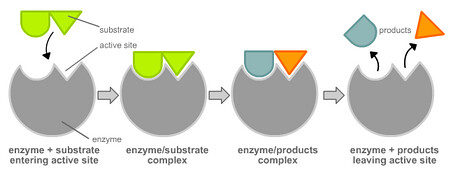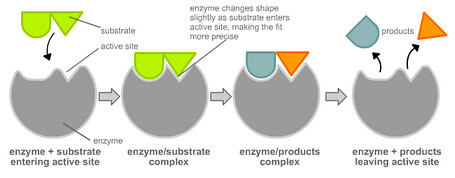Metabolism is the biochemical modification of chemical compounds in living organisms and cells. This includes the biosynthesis of complex organic molecules (anabolism) and their breakdown (catabolism). Metabolism usually consists of sequences of enzymatic steps, also called metabolic pathways. The total metabolism are all biochemical processes of an organism. The cell metabolism includes all chemical processes in a cell.
In biochemistry, a metabolic pathway is a series of chemical reactions occurring within a cell, catalyzed by enzymes, to achieve in either the formation of a metabolic product to be used or stored by the cell, or the initiation of another metabolic pathway (then called a flux generating step). Many of these pathways are elaborate, and involve a step by step modification of the initial substance to shape it into the product with the exact chemical structure desired.
A primosome is a complex of two proteins (primase and helicase), that initiates RNA primers on the lagging DNA strand during DNA replication.(Ref.: Figure 24.1 of Biochemistry (3rd Edition) by Christopher K. Mathews, Kensal E. van Holde, Kevin G. Ahern )
E. coli is Escherichia coli (大腸桿菌是現代生物學中研究最多的一種細菌,作為一種模式生物,其基因組序列已全部測出。用分子生物學方法在大腸桿菌得出的結論可用於其它生物的研究。此外,在生物工程中,大腸桿菌被廣泛用於基因克隆和表達的宿主。 Ref.: 大腸桿菌)
酶,又稱為酵素,是具有生物催化功能的生物大分子,即生物催化劑。
* 人們已經發現兩類生物催化劑:
1. 普通酶(Enzyme)是有活細胞合成的、對其特異底物(Substrate)起高效催化作用的蛋白質,是機體內催化各種代謝反應的最主要的催化劑;
2. 核酶(Ribozyme)是具有高效、特異催化作用的核酸,是近年來發現的一類新的生物催化劑,其作用主要是參與RNA
An enzyme (from Greek énsimo (ένζυμο), formed by én = at or in and simo = leaven or yeast) is a protein that catalyzes, or speeds up, a chemical reaction.
In biochemistry, a substrate is a molecule which is acted upon by an enzyme.
A catalyst (Greek: καταλύτης, catalytēs) is a substance that accelerates the rate (speed) of a chemical reaction without itself being transformed or consumed by the reaction (see also catalysis). A catalyst participates in the reaction but is neither a chemical reactant nor a chemical product.
如果說,enyzme 的是生化反應的催化劑,catalyst 也是催化劑,那 enzymes-catalyzed process 指的是什麼?
"Lock and key" hypothesis: Enzymes are very specific and it was suggested by Emil Fischer in 1890 that this was because the enzyme had a particular shape into which the substrate(s) fit exactly. This is often referred to as "the lock and key" hypothesis. An enzyme combines with its substrate(s) to form a short lived enzyme-substrate complex.
Induced fit hypothesis
In 1958 Daniel Koshland suggested a modification to the "lock and key" hypothesis. Enzymes are rather flexible structures. The active site of an enzyme could be modified as the substrate interacts with the enzyme. The amino acids sidechains which make up the active site are molded into a precise shape which enables the enzyme to perform its catalytic function. In some cases the substrate molecule changes shape slightly as it enters the active site.
A suitable analogy would be that of a hand changing the shape of a glove as the glove is put on.
The active site of an enzyme is the binding site where catalysis occurs. The structure and chemical properties of the active site allow the recognition and binding of the substrate.
Tag: [Bio]

沒有留言:
張貼留言